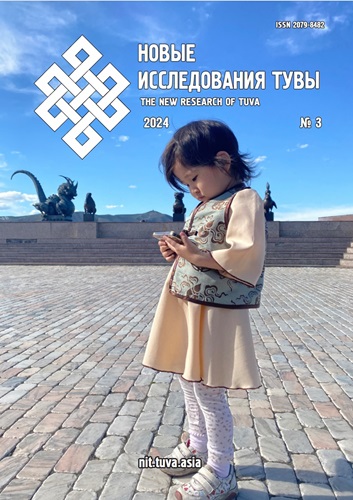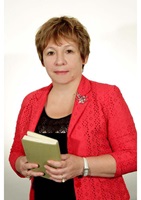Turkic mythology in E. Tursunov's novella “Kelin”
DOI:
https://doi.org/10.25178/nit.2024.3.17Keywords:
Kelin; Ermek Tursunov; myth; Turkic mythology; mythopoetics; Kazakh literatureAbstract
The article analyzes the novel “Kelin” by the modern Kazakh writer Ermek Tursunov, which addresses the origins of the existence of Turkic peoples and reflects ancient Turkic mythological ideas about the world order in its artistic ontology. The story's world includes zoomorphic and cosmic images that resemble the plots and episodes from ancient Turkic mythology, forming a unity with the earthly world. These images embody various aspects of the mythical order, while products and objects also hold mythological significance.
The few images of the heroes are placed in a mythically significant space. Each character represents one of the fundamental roles: the continuation of the family, the protector, the provider, the guardian of the hearth, and the keeper of traditions. Among the mythically significant zoomorphic images, the figure of a totemic animal, the she-wolf, stands out. This image appears in the ancestral myth as the progenitor of the Turkic people.
The mythological contexts recaptured in the story reinforce the allegorical theme of the work. The genre poetics of the text is characterized by a reduction of socio-political realities, the prevalence of mythological and traditional principles. The idea of continuity within the genre forms the basis for the semantic structure of the story.
References
Alekseev, N. A. (1992) Traditional religious beliefs of the Turkic-speaking peoples of Siberia. Novosibirsk, Nauka, Sibirskoe otdelenie. 242 p. (In Russ.).
Anokhin, A. V. (1924) Materials on shamanism among the Altaians: (collected during travels in Altai in 1910–1912 on behalf of the Russian Committee for the Study of Central and East Asia). Leningrad, RAS Publ. 152 p. (In Russ.).
Bisenbaev, A. (2018) Myths of the ancient Turks. Almaty, Mektep. 176 p. (In Russ.).
Varlamova, I. Yu., Budil'tseva, M. B., Pugachev, I. A. and Kuular, E. M. (2023) The image of a woman in the linguistic picture of the world of Tuvans and Russians (based on the material of phraseology in paroemias). New Research of Tuva, no. 4, pp. 44–60. (In Russ.). DOI: https://doi.org/10.25178/nit.2023.4.3
Zhurakuziev, N. I. (2021) Model of the world order in the literature and folklore of the ancient Turkic peoples. Bulletin of L. N. Gumilyov Eurasian National University. Philology Series, no. 1 (134), pp. 23–36. (In Russ.). DOI: https://doi.org/10.32523/2616-678X-2021-134-1-23-36
Golosovker, Ya. E. (1987) The logic of the myth. Moscow, Nauka. 247 p. (In Russ.).
Grebneva, M. P. (2009) The conceptual sphere of the Florentine Myth in Russian literature. Tomsk, Tomsk University Press. 182 p. (In Russ.).
Dushenkova, T. R. (2019) Food code: the names of dairy and fermented milk drinks in the Udmurt language and culture. Istoriko-kul'turnoe nasledie narodov Uralo-Povolzh'ia, no. 1 (6), pp. 67–75. (In Russ.).
Kozubovskaia, G. P. (2008) The middle of the XIX century: myth and mythopoetics. Barnaul, BGPU. 260 p. (In Russ.).
Kairbekov, B. G. (2011) National rituals and traditions. Kazakh etiquette. Almaty, Empire. 110 p. (In Russ.).
Kairbekov, B. (2014) The world of Nomadism. Myths of the Great Steppe. Kazakh etiquette. Astana, Kazakh Scientific Research Institute of Culture. 256 p. (In Russ.).
Kondybai, S. (2005) Kazakh mythology. A short dictionary. Almaty, Nurly Alem. 272 p. (In Russ.).
Kempbell, D. (1997) The Hero with a Thousand Faces: A myth. The archetype. The unconscious. Moscow, Sofiia. 336 p. (In Russ.).
Losev, A. F. (2001) The Dialectic of myth. Moscow, Mysl'. 558 p. (In Russ.).
Meletinskii, E. M. (2000) The Poetics of myth. Moscow, Vostochnaia literatura. 407 p. (In Russ.).
Meletinskii, E. M. (2001) From myth to literature. Moscow, RGGU. 169 p. (In Russ.).
Naurzbaeva, Z. (2021) The eternal sky of the Kazakhs. Almaty, OTUKEN. 720 p. (In Russ.).
Polonskii, V. V. (2008) Mythopoetics and genre dynamics in Russian literature of the late XIX — early XX century. Moscow, Nauka. 285 p. (In Russ.).
Potapov, L. P. (1991) Altai shamanism. Leningrad, Nauka, Leningradskoe otdelenie. 320 p. (In Russ.).
Potapov, L. P. (1991) Elements of religious beliefs in ancient Turkic genealogical legends. Sovetskaia etnografiia, no. 5, pp. 79–86. (In Russ.).
Propp, V. Ia. (1976) Folklore and reality. Moscow, Nauka. 326 p. (In Russ.).
Seidimbek, A. (2012) The world of Kazakhs. Ethnocultural reinterpretation. Astana, Foliant. 560 p. (In Russ.).
Skobelev, S. G. (2022) Ancient turkic goddess of fertility Umai: a mountain and a temple on the Yenisei. Universum Humanitarium, no. 1, pp. 143–152. (In Russ.). DOI: https://doi.org/10.25205/2499-9997-2022-1-143-152
Suvandii, N. D. (2023) Cher ‘earth’ in Tuvan paroemias. New Research of Tuva, no. 1, pp. 26–37. (In Russ.). DOI: https://doi.org/10.25178/nit.2023.1.2
Telegin, S. M (2005) The Mythological space of Russian literature. Moscow, The Pushkin State Institute of the Russian Language. 158 p. (In Russ.).
Temirgazina, Z. K., Nikolaenko, S. V., Shakharam, A. P., Apaeva, S. Kh. (2023) Names of women by marital status: component analysis (based on the Tuvan and Kazakh languages). New Research of Tuva, no. 4, pp. 124–138. DOI: https://doi.org/10.25178/nit.2023.4.9
Toporov, V. N. (1995) Myth. Ritual. Symbol: Research in the field of mythopoeic. Favourites. Moscow, Progress; Kul'tura. 624 p. (In Russ.).
Toporov, V. N. (2004) Research on etymology and semantics. Moscow, Languages of Slavic culture. Vol. I: Theory and some of its particular applications. 816 p. (In Russ.).
The traditional worldview of the Turks of Southern Siberia. Space and time. The Material world (1988) / ed. by I. N. Gemueva. Novosibirsk, Nauka, Sibirskoe otdelenie. 225 p. (In Russ.).
Tursunov, E. D. (2004) The origin of Kazakh folklore speakers. Almaty, Daik-Press. 322 p. (In Russ.).
Eliade, M. (2000) Aspects of the myth. Moscow, Akademicheskii proekt. 222 p. (In Russ.).
Jung, K. G. (2019) Archetypes and the collective unconscious. Moscow, Izdatel'stvo AST. 496 p. (In Russ.).
Freidenberg, O. M. (1997) The poetics of the plot and genre. Moscow, Labirint. 448 p. (In Russ.).
Freidenberg, O. M. (1998) Myth and literature of antiquity. Moscow, Vostochnaia literatura. 800 p. (In Russ.).
White, J. J. (1971) Mythology in the Modern Novel. A study of Prefigurative techniques. Princeton University Press. 246 p.
Published
How to Cite
For citation:
Sabyrzhanova M. S. and Ananyeva S. V. Turkic mythology in E. Tursunov’s novella “Kelin”. New Research of Tuva, 2024, no. 3, pp. 289-301 (In Russ.). DOI: https://doi.org/10.25178/nit.2024.3.17
Issue
Section

This work is licensed under a Creative Commons Attribution-NonCommercial 4.0 International License.

Author(s) license holder(s) grant rights for their work to the journal (grantee of a license) under the simple non-exclusive open license in accordance with Art. 1286.1 «Open license for a research work, work of literature or fine arts», Civil Code of the Russian Federation.
New Research of Tuva publishes articles under the Creative Commons Attribution-NonCommercial license (CC BY-NC).
Since it is an open license, author(s) reserve the right to upload the article to their institutional repository, submit it to another journal (if it allows republications), or republish it on their own website (in full, or in part).
However, several conditions apply here:
a) The republished version must always contain the name(s) and affiliation(s) of the author(s), the original title and the hyperlink to the original version on the New Research of Tuva website;
b) It must be in open access, free of charge, and no category of readers must be in any way whatsoever advantaged over general readership.
c) should the contribution be submitted elsewhere by its author(s) without substantial modification (30% or more of original text unchanged), the body of the article should contain a disclaimer that the original version was published in New Research of Tuva (with a link to the respective page)
The CC-BY-NC is a non-revocable license which applies worldwide and lasts for the duration of the work’s copyright.










